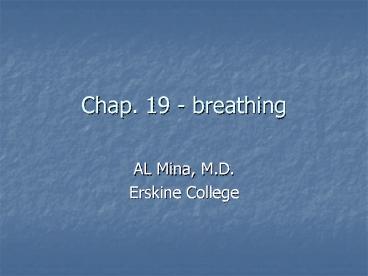Chap' 19 breathing - PowerPoint PPT Presentation
1 / 32
Title: Chap' 19 breathing
1
Chap. 19 - breathing
- AL Mina, M.D.
- Erskine College
2
Air movement
- Inspiration and expiration occur due to
differences in air pressure - Atmospheric pressure (sea level) 760 mmHg
- At rest (lungs), pressure in lungsatmospheric
pressureno air movement
3
Figure 19.21
4
Inspiration
- Inspiratory muscles activated
- Diaphragm
- External intercostals
- Phrenic nerve stimulates contraction
- Actions expand rib cage, increase vol. of
thoracic cavity - As volume increases, pressure decreases
- When pressure in lungsltatm pressure, air flows in
5
Figure 19.23
6
- During deep inspiration, accessory muscles used,
plus diaphragm/intercostals stimulated to
contract further
7
Figure 19.24
8
Lung expansion
- Not attached to rib cage
- Moves due to interaction of pleural membranes
- Adherence due to pleural fluid
- As chest wall expands, lungs follow
- Compliance ability of lungs to expand
9
Exhalation
- Muscles relax
- Elastic recoil of lungs allows them to return to
original shape - Abdominal organs press upward
- Increase pressure causes exhalation
- Maximal exhalation
- Internal intercostals
- Abdominal muscles
10
Figure 19.25
11
Spirometry
- Measurement of respiratory air volumes
- 4 volumes of air
- Combine volumes to calculate respiratory
capacities
12
Volumes
- Tidal volume (TV) air that moves during normal
breathing - Inspiratory reserve volume (IRV) additional air
that can be inspired during maximal inhalation - Exp. Res. Vol. (ERV) air moved beyond normal
exhalation - Residual volume (RV) air that is left after ERV
13
Capacities
- Insp. Capacity (IC) total vol. inspired from
normal exhalation (TVIRV) - Functional residual capacity (FRC) vol. in
lungs after normal exhalation (ERVRV) - Vital capacity (VC) total volume of air that can
be moved (IRVTVERV) - Total lung capacity (TLC) VCRV
14
Figure 19.26
15
Dead space
- Volume of air that doesnt undergo gas exchange
- Anatomic dead space volume in trachea, bronchi,
etc that doesnt reach alveoli - Alveolar dead space alveoli that dont exchange
due to poor blood flow - Physiologic dead space total of above spaces
(normal 150 ml)
16
Dead space importance
- As dead space increases, effective TV decreases
(or as TV decreases) - May increase work of breathing by incorporating
accessory muscles to breathe normally
17
Nonrespiratory air movements
- Cough force air against closed glottis, then
open suddenly - Sneeze same thing, just comes out nose (uvula
redirects flow upward) - Laughing/crying series of short exhalations
- Hiccup spasm of diaphragm
- Yawn - ? May be CNS effect
18
Figure 19.28
19
Control of breathing
- Respiratory areas in brainstem
- Adjust rate and depth of breathing
- Medullary rhythmicity center
- Dorsal respiratory group diaphragm
- Ventral respiratory group abdominals,
intercostals
20
Contd
- Pontine respiratory group
- Contribute to rhythm
21
Influences on breathing
- Partial pressures
- Central chemoreceptors
- Detect central hydrogen ions, formed from influx
of CO2 into brain - Peripheral chemoreceptors
- Detect O2 levels
- Minor effect deoxygenated blood at 75
capacity, receptors activated at 50
22
Alterations in breathing
- Breath-holding
- Increases CO2, stimulates respiratory center
- Hyperventilation
- Increases O2, decreases CO2
- Delays stimulation of respiratory center
- can cause alkalosis, cerebral vasoconstriction,
fainting
23
Gas exchange
- Alvoli contain respiratory pores to interact
with each other - Respiratory membrane
- Alveolar Epithelium
- Alveolar basement membrane
- Capillary basement membrane
- Capillary epithelium
24
(No Transcript)
25
Figure 19.33
26
Alveolar cells
- Type I epithelial cells
- Type II surfactant secreting cells
- Surfactant decreases surface tension, allows
alveoli to remain open - Alveolar macrophages
27
Diffusion
- Gases move from high to low concentration
- Atmosphere PO2 160 mmHg, PCO2 0.3
- Alveoli PCO2 40, PO2 104
- Pulm. Venules PCO2 45, PO2 40
- Pulm. Arterioles PCO2 40, PO2 104 (same as
alveoli)
28
Figure 19.35
29
Transport
- O2 bound to hemoglobin (98) or dissolved in
plasma - Increased PO2increased saturation of hemoglobin
- PO2 high in lungs, so O2 binds
- PO2 low in tissues, so O2 releases
30
Effect of carbon dioxide on hemoglobin binding
oxygen
90
At PO2 50 mmHg
80
65
As you increase PCO2, decrease saturation of
hemoglobin at any given PO2.
More oxygen is released at higher partial
pressure of CO2.
31
- O2 release increases with increase in
temperature, CO2, or acidity - All commonly found in areas of active cell
metabolism
32
CO2 transport
- Dissolved in plasma (7)
- Bound to hemoglobin (15-25)
- Bicarbonate ions (HCO3-)
- CO2H20 --? H HCO3-































